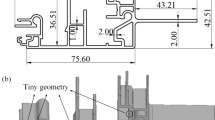Abstract
During the extrusion process of aluminum alloy, the ram velocity should be well controlled, since it is an important parameter affecting the profile quality and extrusion productivity. The effects of ram velocity on conventional porthole die extrusion have been investigated by some researchers, while its influence on pyramid die extrusion has not been fully clarified. Thus, in this study, the pyramid die extrusion process for producing a hollow rectangular aluminum tube was comprehensively investigated by performing analysis of steady state, transient state, and billet skin tracking. Importantly, the effects of ram velocity on some evaluation parameters of pyramid die extrusion, such as the material flow behavior, extrudate temperature, extrusion force, transverse weld, quality of longitudinal weld, and back end defect, were overall investigated. The results show that the flowing velocity, extrudate temperature, extrusion force, and welding pressure tend to increase as the increase of ram velocity, while the length of transverse weld is reduced at higher ram velocity. However, the effect of ram velocity on the back end defect is quite slight. Moreover, the advantages and shortcomings of pyramid die were also discussed by comparing with the conventional porthole die.
Similar content being viewed by others
References
Mahmoodkhani Y, Wells MA, Parson N, Poole WJ (2014) Numerical modelling of the material flow during extrusion of aluminium alloys and transverse weld formation. J Mater Process Technol 214(3):688–700
Chen L, Zhao G, Yu J, Zhang W, Wu T (2014) Analysis and porthole die design for a multi-hole extrusion process of a hollow, thin-walled aluminum profile. Int J Adv Manuf Technol 74(1–4):383–392
Rout AK, Maity K (2011) Numerical and experimental study on the three-dimensional extrusion of square section from square billet through a polynomial shaped curved die. Int J Adv Manuf Technol 54(5–8):495–506
Sheppard T, Niu L, Velay X (2013) Investigation of metal flow in bridge die extrusion of Alloy 6063 and subsequent effect on surface quality and weld seam integrity. Mater Sci Technol 29(1):60–68
Hwang YM, Chen JM (2013) Surface permeation and die design during rodextrusion processes. Int J Adv Manuf Technol 69(1–4):397–403
Li F, Lin JF, Yuan SJ, Liu XJ (2009) Effect of inner cone punch on metal flow in extrusion process. Int J Adv Manuf Technol 42(5–6):489–496
Chen H, Zhao G, Zhang C, Guan Y, Liu H, Kou F (2011) Numerical simulation of extrusion process and die structure optimization for a complex aluminum multicavity wallboard of high-speed train. Mater Manuf Proc 26(12):1530–1538
Donati L, Tomesani L (2005) The effect of die design on the production and seam weld quality of extruded aluminum profiles. J Mater Process Technol 164:1025–1031
Zhang C, Zhao G, Chen H, Guan Y, Li H (2012) Optimization of an aluminum profile extrusion process based on Taguchi’s method with S/N analysis. Int J Adv Manuf Technol 60(5–8):589–599
Bastani AF, Aukrust T, Brandal S (2011) Optimisation of flow balance and isothermal extrusion of aluminium using finite-element simulations. J Mater Process Technol 211(4):650–667
Jo HH, Lee SK, Jung CS, Kim BM (2006) A non-steady state FE analysis of Al tubes hot extrusion by a porthole die. J Mater Process Technol 173(2):223–231
Abdul Jawwad AK, Barghash MA (2013) Evaluating the effects of process parameters on maximum extrusion pressure using a new artificial neural network-based (ANN-based) partial-modeling technique. Int J Adv Manuf Technol 68(9–12):2547–2564
Fang G, Zhou J, Duszczyk J (2009) Extrusion of 7075 aluminium alloy through double-pocket dies to manufacture a complex profile. J Mater Process Technol 209(6):3050–3059
Ketabchi M, Mohammadi H, Izadi M (2012) Finite-element simulation and experimental investigation of isothermal backward extrusion of 7075 Al alloy. Arab J Sci Eng 37(8):2287–2296
Li Q, Harris C, Jolly MR (2003) Finite element modelling simulation of transverse welding phenomenon in aluminium extrusion process. Mater Des 24(7):493–496
Zhang C, Zhao G, Chen Z, Chen H, Kou F (2012) Effect of extrusion stem speed on extrusion process for a hollow aluminum profile. Mater Sci Eng B 177(19):1691–1697
Reggiani B, Segatori A, Donati L, Tomesani L (2013) Prediction of charge welds in hollow profiles extrusion by FEM simulations and experimental validation. Int J Adv Manuf Technol 69(5–8):1855–1872
Liu G, Zhou J, Duszczyk J (2008) FE analysis of metal flow and weld seam formation in a porthole die during the extrusion of a magnesium alloy into a square tube and the effect of ram speed on weld strength. J Mater Process Technol 200(1):185–198
Hatzenbichler T, Buchmayr B, Umgeher A (2007) A numerical sensitivity study to determine the main influence parameters on the back-end defect. J Mater Process Technol 182(1):73–78
Aymone JLF, Bittencourt E, Creus GJ (2001) Simulation of 3D metal-forming using an arbitrary Lagrangian–Eulerian finite element method. J Mater Process Technol 110(2):218–232
Chen L, Zhao G, Yu J, Zhang W (2015) Constitutive analysis of homogenized 7005 aluminum alloy at evaluated temperature for extrusion process. Mater Des 66:129–136
Wu B, Li MQ, Ma DW (2012) The flow behavior and constitutive equations in isothermal compression of 7050 aluminum alloy. Mater Sci Eng A 542:79–87
Khan YA, Valberg H, Irgens I (2009) Joining of metal streams in extrusion welding. Int J Mater Form 2(1):109–112
Flitta I, Sheppard T (2003) Nature of friction in extrusion process and its effect on material flow. Mater Sci Technol 19(7):837–846
Guan Y, Zhang C, Zhao G, Sun X, Li P (2012) Design of a multihole porthole die for aluminum tube extrusion. Mater Manuf Proc 27(2):147–153
Zhao G, Chen H, Zhang C, Guan Y (2013) Multiobjective optimization design of porthole extrusion die using Pareto-based genetic algorithm. Int J Adv Manuf Technol 69(5–8):1547–1556
Nanninga N, White C, Dickson R (2010) Charge weld effects on high cycle fatigue behavior of a hollow extruded AA6082 profile. J Mater Eng Perform 20(7):1235–1241
Author information
Authors and Affiliations
Corresponding author
Rights and permissions
About this article
Cite this article
Chen, L., Zhao, G. & Yu, J. Effects of ram velocity on pyramid die extrusion of hollow aluminum profile. Int J Adv Manuf Technol 79, 2117–2125 (2015). https://doi.org/10.1007/s00170-015-7059-5
Received:
Accepted:
Published:
Issue Date:
DOI: https://doi.org/10.1007/s00170-015-7059-5



